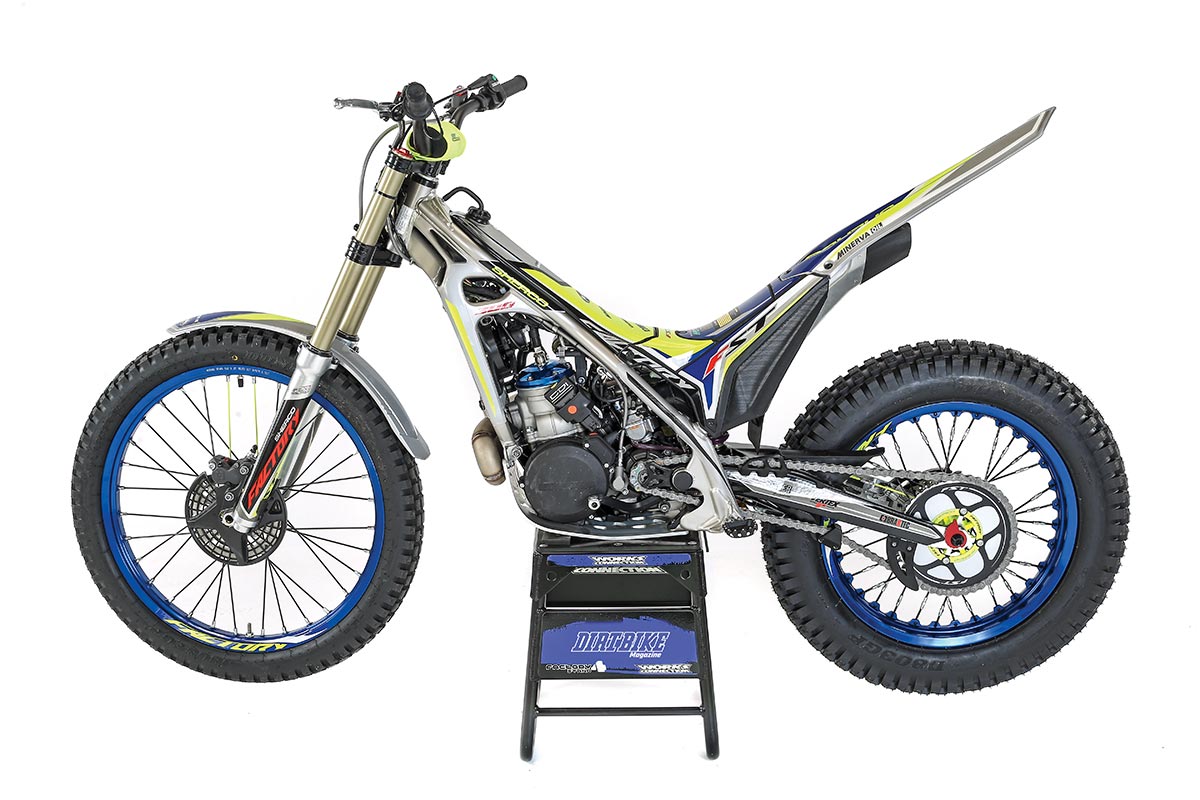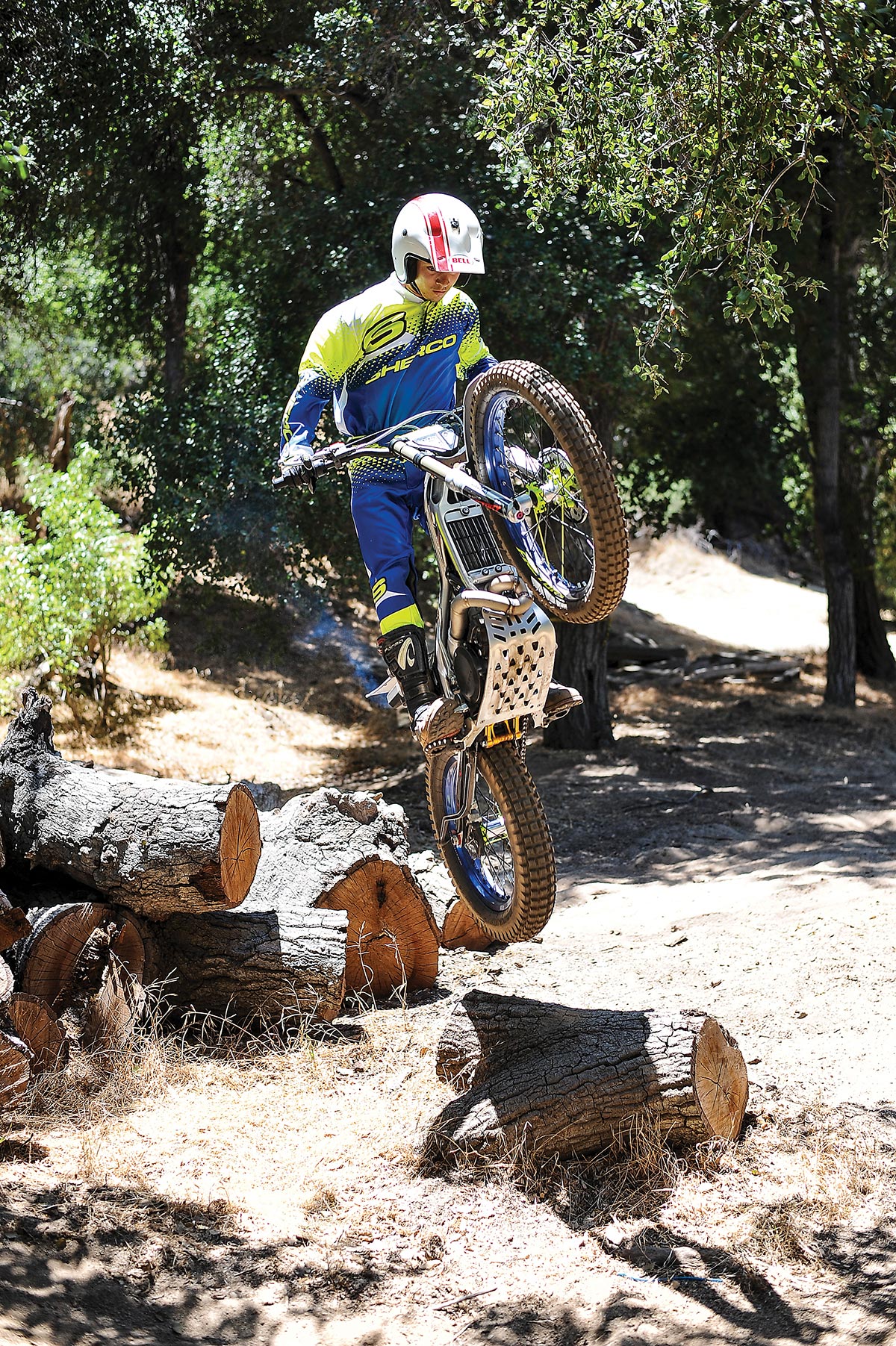Trials is a unique sport. Many of the brands that are mainstream in the trials world are unknown to a large percentage of the dirt riding public in the States. Sherco, a French manufacturer, has bolted into the limelight here in America with the signing of Cody Webb, but the company has been a mainstream trials staple for years. We’ve put some time on the 2020 Sherco 300 FST and have come away impressed in all departments.
The 300 FST is serious. Light, manageable and a potent motor highlight this trials weapon.
INSIDE THE 300 FST
Cutting weight is the name of the game in trials. The obstacles that the top riders are conquering are insanely massive, and every extra ounce is a hindrance to the trials aficionado. The chassis is a super-lightweight tubular section chromoly, and with the titanium header pipe and small fuel capacity of the 0.63-gallon tank, Sherco has brought the weight down to 143 pounds. The machine comes loaded with trick parts, and Sherco has wrapped it with the same factory graphics you would find on Pat Smage’s factory Sherco.
It comes standard with S3 “Hardrock” footpegs. These are high-dollar pegs that offer great grip and a nice platform. The Sherco is fit with an electric fan to help with cooling, since trials speeds are low and overheating can be a problem. The suspension is handled with a Tech 39mm fork with 6.5 inches of travel and two available settings. The right fork has an adjustable end stroke (compression damping), while the left fork is rebound. The front is sprung with progressive springs, and both adjusters are on top. Out back, Sherco uses an amazing three-way-adjustable Reiger rear shock with 6.9 inches of travel. Braktec handles all of the hydraulics on the bike. The front and rear disc systems are compact yet incredibly strong, and the clutch pull is monumentally soft, which is crucial for the trials pilot who uses it mercilessly. Sherco uses a Vertex piston in the liquid-cooled 5-speeder.
 ON THE ROAD
ON THE ROAD
The Sherco fires to life immediately via a crisply jetted Keihin 28mm carburetor. We mixed our bike at a 70:1 ratio and were extremely pleased with how cleanly it ran. Sherco recommends 98-octane fuel, but we were able to get away with premium 91 octane here in California. We occasionally experienced some light “pinging” under a load, but nothing terrible or threatening by any means. Trials motors are usually fairly high compression, and the Sherco has an incredibly trick anodized-blue head made by Oxia. The power the Sherco produces is obviously focused on low-end torque, which it has never-ending amounts of, but we were extremely surprised how high the bike revved out. The Sherco produces big power and makes tackling large obstacles a reasonable request with a motor that easily revs out this high and so clean. Even so, the Sherco resists stalling very well, and the power is still manageable and easy to control.

The Sherco comes with a 5-speed transmission with a very tight selection between the gears. Most trials bikes have a 5- or 6-speed gearbox, and fourth through fifth are usually fairly high. The Sherco has a very low overall gear ratio in each specific gear. It is nice for trials-specific riding to be able to use second and third more often to load the motor and get traction on slippery obstacles. Fourth and fifth are very low compared to other trials bikes, but certainly get the job done to transfer to the next trials section.

Quality suspension is a trials rider’s dream. The forks are made by Tech and come fit with a generous amount of adjustability. They provide strong performance and are valved with proper rebound damping and a stellar amount of bottoming resistance for large drops. The standard settings to the fork worked well for our smaller test rider. The left fork uses a progressive-adjustable spring for end-stroke adjustment, and the right fork is your rebound, while all adjustments can be made up top on the fork caps. In the rear, the Reiger shock is a very high-end item. It is a three-way adjustable shock that is extremely plush. It offers proper rebound for hopping the bike, yet can handle the largest drops without bottoming. We are very impressed with the balance of the suspension both front and rear.

The tubular chassis is super light and incredibly balanced. All of the bodywork is very smooth and clean. The bike feels very slim; every item on the Sherco is tucked in tight so as to not interfere with the rider moving around on the bike. The chassis feels very stable, and the light weight is distributed very nicely. The 0.63-gallon tank features a reserve petcock and offered us a few hours of trials riding before hitting reserve. The bike did seem a bit thirstier than other trials bikes we’ve tested.
The wheels are made by Morad and are an attractive anodized blue. The hubs are CNC-machined with powdercoated neon -yellow accents around the outer portion. The wheels are wrapped in Dunlop 803GP tires. These are extremely sticky tires and provide an abundance of traction on both ends. Rear-wheel and chain adjustments are easily made with the snail adjusters on the outside of the swingarm.

The Braktec hydraulics are common on most trials brands, and that’s a good thing. They are strong, don’t fade and offer tremendous feel. They both performed very predictably, and the pressure never changed, even under extreme abuse. The clutch uses mineral oil, and the pull is almost nonexistent. There is zero fade with very precise and quick action when needed.
Other small items are the Oxia bars and grips, designed with a comfortable bend and overall height for the rider. The Sherco also has a sano LED headlight that’s fairly bright in case your trials sessions go a bit late into the evening. Air-filter access and maintenance were a no-brainer, and standard maintenance proved to be elementary.

ADDING IT UP…
Throughout our Sherco test, we had our GasGas TXT300 and a 2017 Beta EVO 300 along for comparison’s sake. The Sherco and GasGas feel similar in terms of ergonomics, whereas both the GasGas and Beta feel heavier and require a bit more effort to tackle the same obstacles. The Sherco was the easiest to adapt to. It also has the most peak power and revs out, whereas the GasGas and Beta are a bit smoother throughout the entire powerband. All three bikes have exceptional components and excellent clutches and brakes. The Sherco is a very competitive bike, and you feel it when you compare it to the others. It’s more aggressive, and it looks more aggressive. Out of the box, the Sherco is a race-ready and competition-tuned machine. It sells for $8599. www.shercousa.com





Comments are closed.